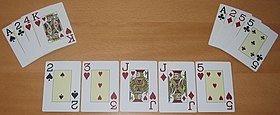Pot Limit Omaha Hi Lo 8 Or Better
Limit Omaha 8 or better (LO8) is a game of hand selection and controlling the number of people you’re playing against. The absolute 100% truth of this game is that any hand worth playing generally has an ace in it. There are ZERO premium hands in this game that don’t have an ace and a wheel card. Is pretty, but requires a very specific board. The low hand winner is the player with the best hand featuring five unpaired cards valued 8 or lower. Flushes and straights are ignored in the low hand. If you know the basics of Pot Limit Omaha Hi strategy, you should have no problems getting to grips with Omaha Hi Lo. Limit is Easier, but Pot Limit is Where the Big Bucks are Made. Just like Texas holdem is spread in.
Just like Texas holdem is spread in limit and no limit, Omaha 8 is commonly available in limitand pot limit.
You can grind out profit playing limit, but the potential profit in pot limit games is much higher.
If another player held the nut low as well but your high hand was the winner, you would win three quarters of the pot made up of the high half and half of the low half. While this Omaha/8 hand offers no low possibility, since you must use two cards from your hand, it does offer two nut flushes, straight possibilities with two different high pairs which could make sets and then, if the board pairs, very good.
Over the years I’ve played both limit and pot limit and have found that the play at pot limit isn’t much different than at the limit tables. This is good news because once you learn how to beatOmaha 8 you can use your skills playing pot limit and increase your hourly profit.
The same skill set is needed in both games, but you profit more from your opponent’s mistakes in pot limit. The only adjustment I make when playing pot limit instead of limit is I play a slightly tighter starting hand game.
The downfall of most losing Omaha 8 players is they play too many hands. They think that because they have twice as many cards in their starting hand they can play more hands. But the opposite istrue.
All poker games are based on mathematical calculations and principles, but Omaha offers a clearer picture fromthe beginning as far as math is concerned. In Texas holdem you know the value of two cards from the deck of 52 cards when you see your starting hand.
In Omaha you know the value of four cards out of 52 when you see your starting hand. This is twice the percentage of known cards and also reduces the possibility of what your opponents have bytwo additional cards.
When you see the flop in Texas holdem you know the value of five cards, but in Omaha you know the value of seven. After the river is dealt you know the value of nine cards out of 52.
Poker is a game of limited information so you need to be able to make educated guesses about what your opponents hold. You make these decision based on the cards you know the value of and theactions of your opponents.
The greater the amount of information you have the better you can make these decisions.
Omaha gives you more information in known cards than Texas holdem so you can use simple math to help you more in Omaha.
When you’re able to use what you know better than your opponents it creates profitable situations. This profit is multiplied in pot limit over limit because your opponent’s mistakes cost themmore money.
I recommend starting at the Omaha 8 limit tables and working on your game there until you learn how to be a winning player.

But as soon as you learn how to win you need to start investigating the pot limit game to increase your profits.
The rest of the tips and strategies on this page can be used in limit play and pot limit play to improve your game.
Table Of Contents
What is Omaha Hi-Lo Split-8-or-Better Poker?
If you know how to play pot-limit Omaha (or 'Omaha high'), you are well on your way to learning how to play Omaha hi-lo.
As the name suggests, Omaha hi-lo is a 'split-pot' version of Omaha poker in which players compete for both the 'high' and 'low' halves of the pot. Omaha hi-lo is usually played with fixed-limit betting and often turns up in 'mixed game' formats like H.O.R.S.E. (in which Omaha hi-lo is the 'O') or the popular 8-game mix.

You will sometimes see the game referred to simply as 'Omaha 8' or even 'O/8' or more elaborately as 'Omaha hi-lo split-pot-8-or-better.' The name gets styled differently, too, as 'Omaha High-Low,' 'Omaha poker high-low' and so on.
Pot-limit and no-limit versions of Omaha hi-lo are also popular, especially online either as cash games or tournaments.
How to Play Omaha Hi-Lo Split-8-or-Better Poker
The basic rules for Omaha hi-lo are very similar to pot-limit Omaha. See 'How to Play Omaha Poker' for an overview of how to play Omaha poker, which is itself a variation on regular Texas hold'em.
Just like in pot-limit Omaha, players are dealt four cards in Omaha hi-lo and are required to use two of those four cards in combination with three community cards in order to make a five-card poker hand.
As in hold'em or pot-limit Omaha, if a player bets and everyone folds before the showdown, the player wins the pot without having to show a hand. However, if the final bet is called and there is a showdown, hands are examined to see who has the best 'high' hand and who has the best 'low' hand, with each winning one-half of the pot.
Omaha Hi-Lo Split-8-or-Better Rules
In Omaha hi-lo, the 'high' hand is determined exactly the same way as in hold'em or Omaha 'high' games (like PLO), following traditional hand rankings.
Pot Limit Omaha Hi Lo 8 Or Better Call
The 'low' hand requires a little more explanation, especially if you are new to split-pot games or hi-lo poker.
First of all, whatever cards you use to make your high hand, that makes no difference when making your low hand. You can use the same two cards, the other two cards, or any combination just as long as you use two cards from your four-card hand plus three of the community cards to build your five-card poker hand.


The rules of Omaha hi-lo is usually played with a 'qualifier' for the low hand, meaning all of the cards making up a low hand have to be ranked eight or lower. That's where the 'split-8-or-better' comes from, a phrase usually added to the name of the game.
A qualifying low hand consists of five unpaired cards ranked eight or lower. For the low hand, the ace is considered a low card (the lowest), while it can also serve as the highest-ranking card in high hands.
Also worth noting — if your lowest five cards make a straight or a flush, that doesn't matter in Omaha hi-lo, you've still got a low hand (if all are ranked eight or lower). In other 'lowball' games like 2-7 no-limit triple draw, flushes and straights hurt you by making your low hand higher, but in Omaha hi-lo that is not the case.
That means a hand consisting of 5-4-3-2-A would be the lowest possible hand — that is to say, the best 'low hand' in Omaha hi-lo. This hand is sometimes called a 'wheel.' The next lowest possible hand is 6-4-3-2-A. The worst low hand that qualifies as a low in Omaha hi-lo would be 8-7-6-5-4.
A good way to figure out which low hand is best is to arrange the hand from highest card to lowest card and then to think of the hand as a five-digit number, with the lowest number being the best (or lowest) hand. Thus 5-4-3-2-A (54321) is better than 6-4-3-2-A (64321), and 6-4-3-2-A is better than 6-5-3-2-A (65321) and so on.
An Example of an Omaha Hi-Lo Split-8-or-Better Poker Hand
Let's say a hand of Omaha hi-lo goes to showdown with the final board reading 6♣3♠K♦Q♦.
You hold A♣K♠7♦4♣, and your opponent has Q♠J♦4♦2♠.
Your best possible high hand is two pair, aces and kings — using the A♣ and K♠ in your hand pairing them with the ace and king on board, with the queen being a kicker.
Your best possible low hand is 7-6-4-3-A — using the 7♦ and 4♣ in your hand along with the three low cards on the board. Note how you can't use the ace in your hand when making your low hand, since you have to use exactly two cards in your hand and three on the board (and there is an ace on the board).
Your opponent, meanwhile, has you beat both for the high and the low!
Your opponent's best possible high hand is a flush — using the two diamonds in his hand (J♦ and 4♦) and the three diamonds on the board.
Your opponent's best possible low hand is 6-4-3-2-A — using the 4♦ and the 2♠ in his hand along with the three low cards on the board. 64321 is lower than 76431, so your opponent has you beat.
Winning both halves of the pot like this is called a 'scoop' or 'scooping,' which is something you always want to try to do when playing split-pot or hi-lo poker games.
Sometimes in Omaha hi-lo there is no qualifying low hand. This is the case whenever there are less than three unpaired cards ranked eight or lower on the board.
For example, if the board is 9♣K♦A♥4♥J♠, there are only two cards ranked eight or lower on the board (the ace and four), which means it is impossible for anyone to make a low hand. When that happens, whoever has the best high hand scoops the whole pot.
Conclusion
Omaha hi-lo is not difficult to learn, especially if you already know how to play pot-limit Omaha. The strategy can be complicated, though, with a great deal of importance placed on understanding what are strong starting hands (e.g., hands containing an ace with at least one or two low cards, especially a deuce) and not making the mistake of battling for only half of the pot (just the high or low).
Must Have Rooms
Home to the biggest tournaments online, these rooms also have the largest player base, great bonuses, tons of action and the best software. If you don't have accounts here, you are missing out on the best that online poker has to offer.
partypokerplatinum
Up to $30 of Free Play
Pot Limit Omaha Hi Lo
RATING
9.9 ★
Key features
- Excellent mobile poker games
- Lots of free and real-money action
- One of the most trusted brands in online gaming